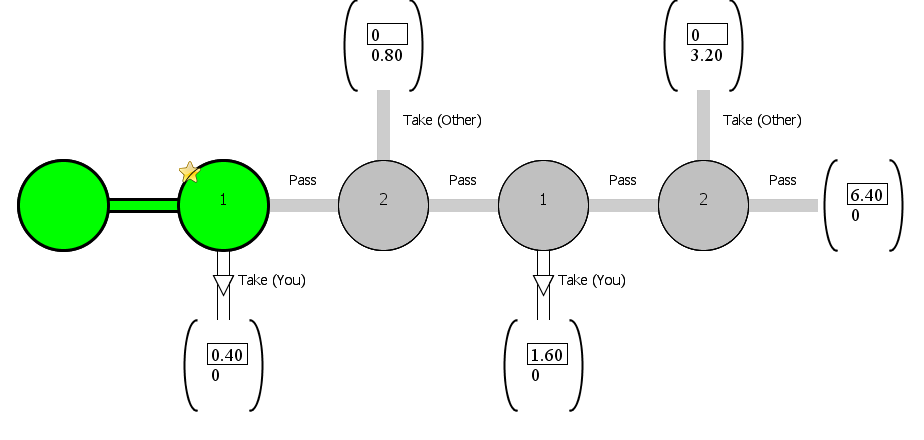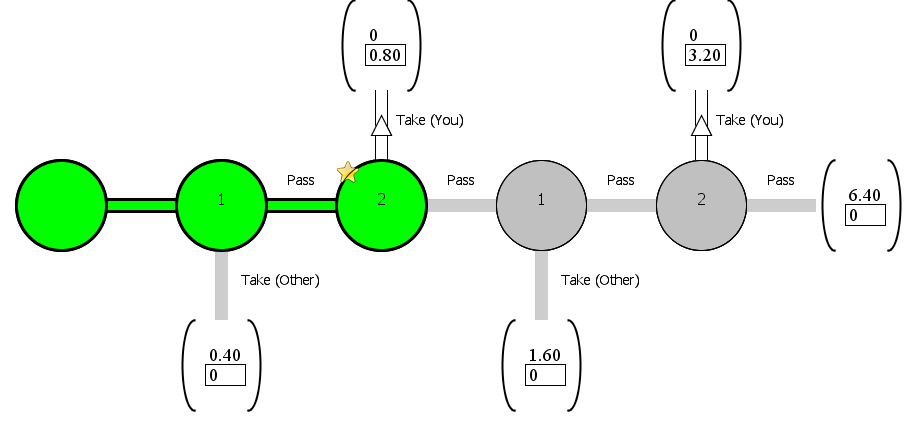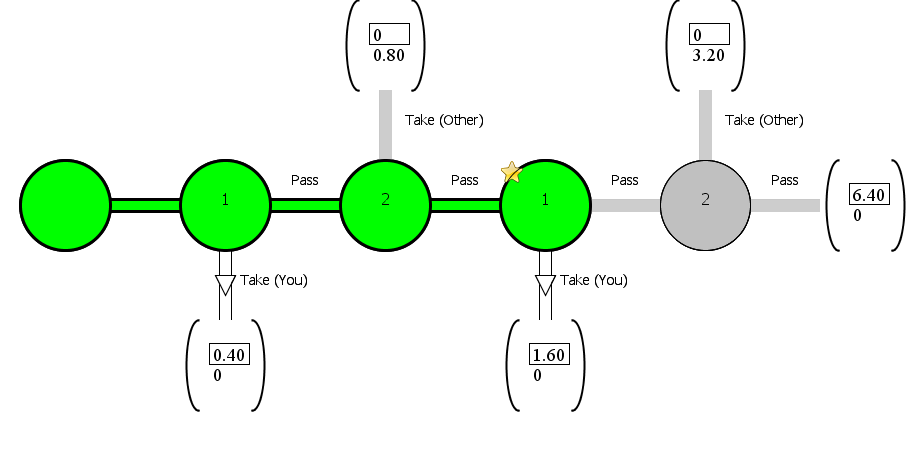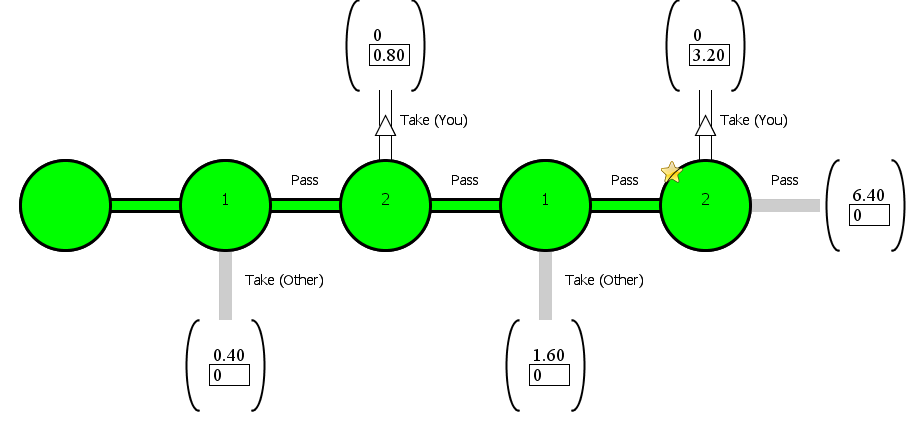This is an experiment in the economics of decision-making.
You will have the opportunity to engage in 10 rounds of a decision procedure.During the experiment you will be participating in a decision procedure in which the participants take turns in choosing between two actions. Those actions are "Take" or "Pass".
If the participant whose turn it is to choose were to select the action "Take", that would end the decision procedure. On the other hand, if the participant whose turn it is to choose were to decide to "Pass", then the proceedings would continue.
In order to choose Take, you would need to click on the arrow labeled Take in the tree diagram before 10 seconds have elapsed.
In order to choose Pass, you would wait for the computer to automatically enter a choice of Pass; the computer will do this after 10 seconds have elapsed.
You will be randomly selected to be either Player 1 or Player 2. You will keep your role as Player 1 or Player 2 throughout the experiment.
Player 1 will always be the first person to choose Pass or Take at the first node. If Player 1 chooses to Pass, Player 2 will get the next turn to Take or Pass.
When the decision procedure begins, there is a ten second pause at the left-most node at which neither player has a decision to make.
At the end of 10 seconds, the gold star moves to first decision node of Player 1, who can then choose to Take or Pass.
LOOKING AT DECISION OPPORTUNITIES FOR PLAYER 1 AT NODE 1
If you are randomly selected to be Player 1 then the below tree diagram shows your available actions and payoffs. The label (1 or 2) at each node indicates who will make a decision at that node.
Player 1’s payoff at a given branch of the tree is the top number; it is outlined by a rectangle in the below tree diagram. The other number, not in the rectangle, is the other person’s payoff.
In order for Player 1 to Take at the first decision node, he/she needs to click on the Take arrow; in that case Player 1 is paid $0.40 and Player 2 is paid $0.
In order for Player 1 to Pass at the first decision node, he/she needs to wait for the computer to automatically enter a choice of Pass after 10 seconds have elapsed; in that case there are no money payoffs so far and Player 2 gets the next turn to Take or Pass.

LOOKING AT DECISION OPPORTUNITIES FOR PLAYER 2 AT NODE 2
If you are randomly selected to be Player 2 then the below tree diagram shows your available actions and payoffs. The label (1 or 2) at each node indicates who will make a decision at that node.
Player 2’s payoff at a given branch of the tree is the bottom number; it is in a rectangle in the below tree diagram. The other number, not in the rectangle, is the other person’s payoff.
In order for Player 2 to Take at the second decision node, he/she needs to click on the Take arrow; in that case Player 2 is paid $0.80 and Player 1 is paid $0.
In order for Player 2 to Pass at the second decision node, he/she needs to wait for the computer to automatically enter a choice of Pass after 10 seconds have elapsed; in that case there are no money payoffs so far and Player 1 gets the next turn to Take or Pass.

LOOKING AT DECISION OPPORTUNITIES FOR PLAYER 1 AT NODE 3
If Player 1 clicks on Take at the third decision node then Player 1 is paid $1.60 and Player 2 is paid $0.
If Player 1 chooses to Pass at the third decision node then there are no money payoffs so far and Player 2 gets the next turn to Take or Pass.

LOOKING AT DECISION OPPORTUNITIES FOR PLAYER 2 AT NODE 4
If Player 2 clicks on Take at the fourth decision node then Player 2 is paid $3.20 and Player 1 is paid $0.
If Player 2 chooses to Pass at the fourth decision node then the decision procedure ends with the payoffs at the end of the tree: Player 2 gets paid $0 and Player 1 gets paid $6.40.

MANY ROUNDS BUT DIFFERENT PLAYERS
You will participate in the decision procedure many times; each participation repetition is called a "round".
You will be randomly selected as either Player 1 or Player 2 in the first round and this role will stay the same in all rounds.
The first player to click on “Take” ends that round and determines the payoffs of both players, which are the payoffs shown at the node where he/she clicks on “Take”.
You will be paid the sum of the payoffs from all rounds.
You will play 10 rounds.
In each round you will be matched with a different person.
Do you have any questions at this time? If so, please raise your hand to notify the experimenter. ONCE YOU CLICK "Finish Reading" YOU WILL EXIT THE INSTRUCTIONS, SO PLEASE ASK ANY QUESTIONS YOU MAY HAVE FIRST. When you have finished reading, and have asked any questions you might have, please click "Finish Reading".